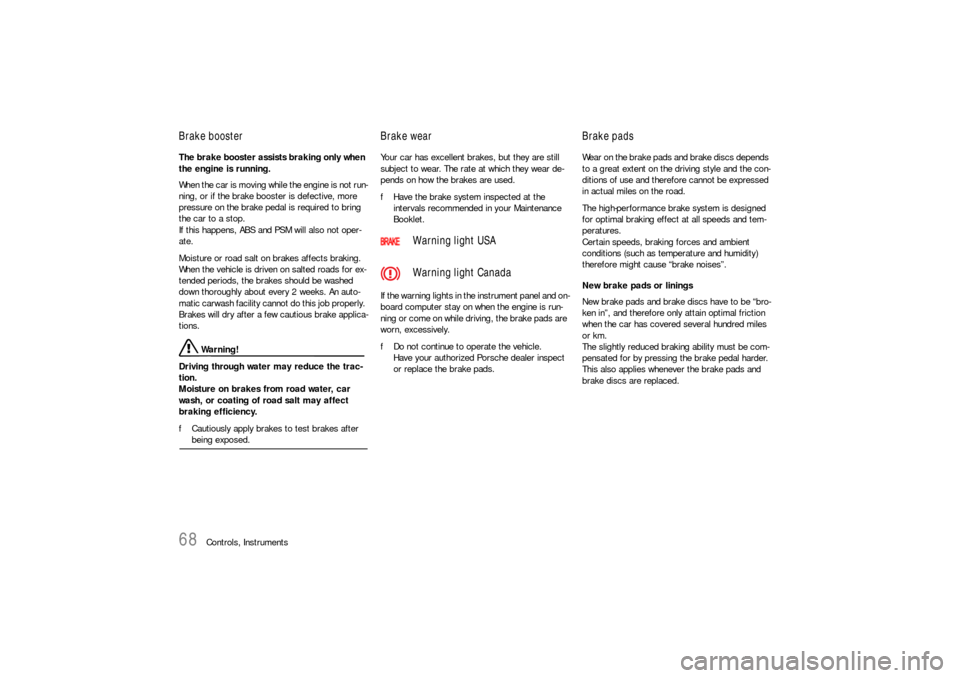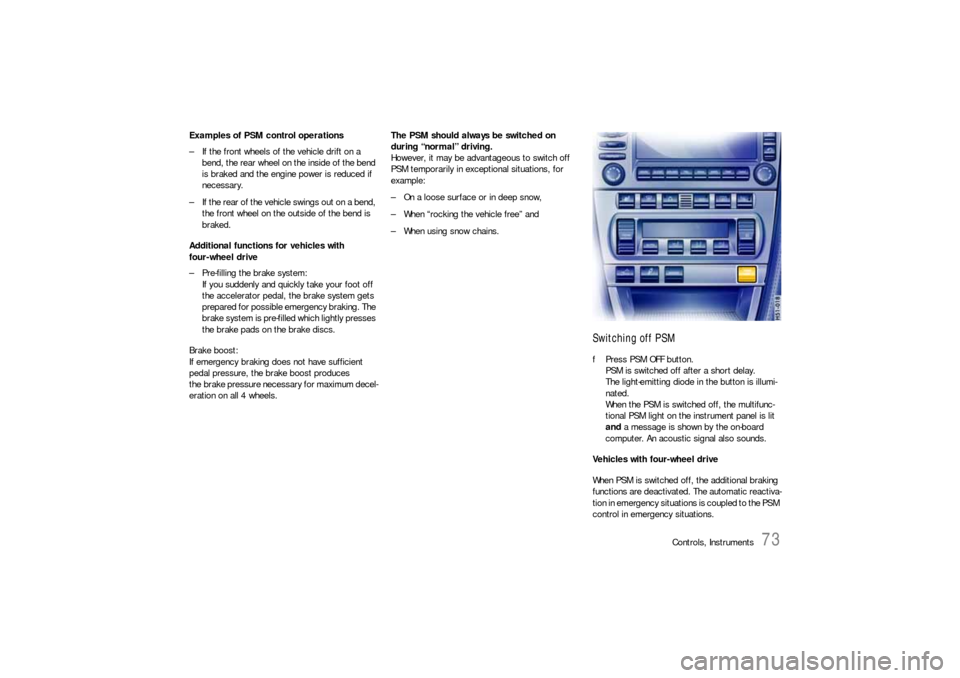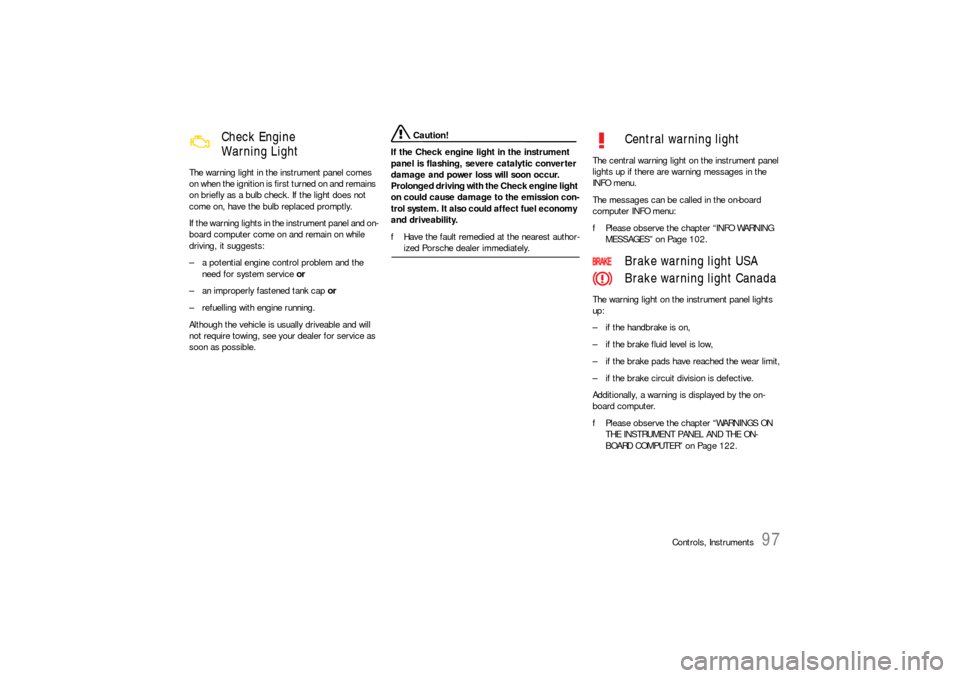brake pads PORSCHE 911 CARRERA 2006 5.G Owners Manual
[x] Cancel search | Manufacturer: PORSCHE, Model Year: 2006, Model line: 911 CARRERA, Model: PORSCHE 911 CARRERA 2006 5.GPages: 308, PDF Size: 3.69 MB
Page 8 of 308

8Porsche Ceramic Composite Brake
(PCCB)The high-performance brake system is designed
for optimal braking effect at all speeds and
temperatures.
Certain speeds, braking forces and ambient
conditions (such as temperature and humidity)
therefore might cause brake noises.
Wear on the different components and braking
system, such as brake pads and brake discs,
depends to a great extent on the individual driving
style and the conditions of use and therefore
cannot be expressed in actual miles on the road.
The values communicated by Porsche are based
on normal operation adapted to traffic. Wear
increases considerably when the vehicle is driven
on race tracks or through an aggressive driving
style.
fPlease consult an authorized Porsche dealer
about the current guidelines in effect before
such use of your vehicle.
Setting and operating vehicle
components when driving
Warning!
There is a danger of accident if you set or op-
erate the on-board computer, radio, naviga-
tion system, telephone or other equipment
when driving.
This could distract you from the traffic and
cause you to lose control of the vehicle re-
sulting in serious personal injury or death.
fOperate the components while driving only if
the traffic situation allows you to do so safely.
fCarry out any complicated operating or setting procedures only with the vehicle stationary.
Portable Fuel Containers
Danger!
Portable fuel containers, full or partially
empty, may leak, causing an explosion, or
result in fire in case of an accident.
fNever carry additional fuel in portable contain-ers in your vehicle.
Page 16 of 308

16
Controls, Instruments
Break in hints for the first
2,000 miles/3,000 kilometers The following tips will be helpful in obtaining opti-
mum performance from your new Porsche.
Despite the most modern, high-precision manufac-
turing methods, it cannot be completely avoided
that the moving parts have to wear in with each
other. This wearing-in occurs mainly in the first
2,000 miles/3,000 km. Therefore: fPreferably take longer trips.
fAvoid frequent cold starts with short-distance
driving whenever possible.
fAvoid full throttle starts and abrupt stops.
fDo not exceed maximum engine speed of
4,200 rpm (revolutions per minute).
fDo not run a cold engine at high rpm either in
Neutral or in gear.
fDo not let the engine labor, especially when
driving uphill. Shift to the next lower gear in
time (use the most favorable rpm range).
fNever lug the engine in high gear at low
speeds. This rule applies at all times, not just
during the break-in period.fDo not participate in motor racing events,
sports driving schools, etc. during the first
2,000 miles/3,000 kilometers.
There may be a slight stiffness in the steering,
gear-shifting or other controls during the break-in
period which will gradually disappear.
Break in brake pads and brake discsNew brake pads and discs have to be “broken in”,
and therefore only attain optimal friction when the
car has covered several hundred miles or km.
The slightly reduced braking ability must be com-
pensated for by pressing the brake pedal harder.
This also applies whenever the brake pads and
brake discs are replaced. New tires New tires do not have maximum traction. They
tend to be slippery.
fBreak in new tires by driving at moderate
speeds during the first 60 to 120 miles/100 to
200 km. Longer braking distances must be an-
ticipated.
Engine oil and fuel consumption During the break-in period oil and fuel consump-
tion may be higher than normal.
As always, the rate of oil consumption depends on
the quality and viscosity of oil, the speed at which
the engine is operated, the climate and road con-
ditions, as well as the amount of dilution and oxi-
dation of the lubricant.
fMake a habit of checking engine oil with every
fuel filling, add if necessary.
Page 68 of 308

68
Controls, Instruments
Brake booster The brake booster assists braking only when
the engine is running.
When the car is moving while the engine is not run-
ning, or if the brake booster is defective, more
pressure on the brake pedal is required to bring
the car to a stop.
If this happens, ABS and PSM will also not oper-
ate.
Moisture or road salt on brakes affects braking.
When the vehicle is driven on salted roads for ex-
tended periods, the brakes should be washed
down thoroughly about every 2 weeks. An auto-
matic carwash facility cannot do this job properly.
Brakes will dry after a few cautious brake applica-
tions.
Warning!
Driving through water may reduce the trac-
tion.
Moisture on brakes from road water, car
wash, or coating of road salt may affect
braking efficiency.
fCautiously apply brakes to test brakes after being exposed.
Brake wear Your car has excellent brakes, but they are still
subject to wear. The rate at which they wear de-
pends on how the brakes are used.
fHave the brake system inspected at the
intervals recommended in your Maintenance
Booklet.
If the warning lights in the instrument panel and on-
board computer stay on when the engine is run-
ning or come on while driving, the brake pads are
worn, excessively.
fDo not continue to operate the vehicle.
Have your authorized Porsche dealer inspect
or replace the brake pads.
Brake pads Wear on the brake pads and brake discs depends
to a great extent on the driving style and the con-
ditions of use and therefore cannot be expressed
in actual miles on the road.
The high-performance brake system is designed
for optimal braking effect at all speeds and tem-
peratures.
Certain speeds, braking forces and ambient
conditions (such as temperature and humidity)
therefore might cause “brake noises”.
New brake pads or linings
New brake pads and brake discs have to be “bro-
ken in”, and therefore only attain optimal friction
when the car has covered several hundred miles
or km.
The slightly reduced braking ability must be com-
pensated for by pressing the brake pedal harder.
This also applies whenever the brake pads and
brake discs are replaced.
Warning light USA
Warning light Canada
Page 73 of 308

Controls, Instruments
73
Examples of PSM control operations
– If the front wheels of the vehicle drift on a
bend, the rear wheel on the inside of the bend
is braked and the engine power is reduced if
necessary.
– If the rear of the vehicle swings out on a bend,
the front wheel on the outside of the bend is
braked.
Additional functions for vehicles with
four-wheel drive
– Pre-filling the brake system:
If you suddenly and quickly take your foot off
the accelerator pedal, the brake system gets
prepared for possible emergency braking. The
brake system is pre-filled which lightly presses
the brake pads on the brake discs.
Brake boost:
If emergency braking does not have sufficient
pedal pressure, the brake boost produces
the brake pressure necessary for maximum decel-
eration on all 4 wheels.The PSM should always be switched on
during “normal” driving.
However, it may be advantageous to switch off
PSM temporarily in exceptional situations, for
example:
– On a loose surface or in deep snow,
– When “rocking the vehicle free” and
– When using snow chains.
Switching off PSMfPress PSM OFF button.
PSM is switched off after a short delay.
The light-emitting diode in the button is illumi-
nated.
When the PSM is switched off, the multifunc-
tional PSM light on the instrument panel is lit
and a message is shown by the on-board
computer. An acoustic signal also sounds.
Vehicles with four-wheel drive
When PSM is switched off, the additional braking
functions are deactivated. The automatic reactiva-
tion in emergency situations is coupled to the PSM
control in emergency situations.
Page 97 of 308

Controls, Instruments
97
The warning light in the instrument panel comes
on when the ignition is first turned on and remains
on briefly as a bulb check. If the light does not
come on, have the bulb replaced promptly.
If the warning lights in the instrument panel and on-
board computer come on and remain on while
driving, it suggests:
– a potential engine control problem and the
need for system service or
– an improperly fastened tank cap or
– refuelling with engine running.
Although the vehicle is usually driveable and will
not require towing, see your dealer for service as
soon as possible.
Caution!
If the Check engine light in the instrument
panel is flashing, severe catalytic converter
damage and power loss will soon occur.
Prolonged driving with the Check engine light
on could cause damage to the emission con-
trol system. It also could affect fuel economy
and driveability.
fHave the fault remedied at the nearest author-ized Porsche dealer immediately. The central warning light on the instrument panel
lights up if there are warning messages in the
INFO menu.
The messages can be called in the on-board
computer INFO menu:
fPlease observe the chapter “INFO WARNING
MESSAGES” on Page 102.
The warning light on the instrument panel lights
up:
– if the handbrake is on,
– if the brake fluid level is low,
– if the brake pads have reached the wear limit,
– if the brake circuit division is defective.
Additionally, a warning is displayed by the on-
board computer.
fPlease observe the chapter “WARNINGS ON
THE INSTRUMENT PANEL AND THE ON-
BOARD COMPUTER” on Page 122.
Check Engine
Warning Light
Central warning light
Brake warning light USA
Brake warning light Canada
Page 125 of 308

Controls, Instruments
125
Oil temperature gauge faulty Have the fault remedied at an authorized
Porsche dealer.
Indicator faulty Coolant indicator failed.
Have the fault remedied at an authorized
Porsche dealer.
Brake pad wear Have the brake pads changed immediately at an
authorized Porsche dealer.
Warning – Brake fluid level Stop immediately in a suitable place.
Do not continue driving. Have the fault remedied
at an authorized Porsche dealer.
Warning – Brake circuit division Stop immediately in a suitable place.
Do not continue driving. Have the fault remedied
at an authorized Porsche dealer.
ABS failure Have the fault remedied at an authorized
Porsche dealer.
PSM off Porsche Stability Management has been swit-
ched off.
PSM on Porsche Stability Management has been swit-
ched on.
PSM failure Have the fault remedied at an authorized
Porsche dealer.
PASM Normal/Sport Indicator for selected PASM mode
PASM failure Have the fault remedied at an authorized
Porsche dealer.
PASM indicator faulty Have the fault remedied at an authorized
Porsche dealer.
Instrument
panelOn-board
computerText display on on-board
computerMeaning/measure
Page 304 of 308

304
Index
IndexAABS (antilock brake system) .......................... 69
Warning light ........................................ 70
Air distribution ............................................ 138
Air filter ...................................................... 215
Airbag.......................................................... 45
Function ............................................... 46
Warning light ..................................49
, 57
Air-conditioning compressor ................138, 140
Alarm system .......................................26, 161
Alcantara ................................................... 226
Antenna .............................................161, 221
Antifreeze................................................... 199
Antilock brake system (ABS) .......................... 69
Warning light ........................................ 70
Ashtray ...................................................... 142
Assembly aids for wheel changes................. 250
Audio operation ..................................159, 160
Auto-button, air conditioning ........................ 138
Automatic .................................................. 215
Air conditioning system ....................... 138
Anti-glare mirrors .................................. 32
Car washes ........................................ 221
Door locking ......................................... 21
Headlight adjustment........................... 132
Speed control ...................... 88
, 136
, 137
Average consumption ...........................99, 121
Average speed .....................................99, 121
BBackrest
Adjustment ........................................... 34
Release ................................................ 34
Battery ....................................................... 258
Care .................................................. 259
Charging ............................................ 259
Putting vehicle into operation ............... 261
Remote control ................................... 263
Removing ........................................... 262
Warning light......................................... 96
Winter operation ................................. 260
Before driving off ................................... 14
, 15
Belts ................................................... 42, 226
Height adjustment ................................. 44
Tensioner ............................................. 42
Warning light......................................... 43
Blower adjustment............................. 139, 141
Brake light......................................... 276, 278
Brakes ....................................................... 205
Brake circuit division warning light ........ 206
Brake pad warning light ......................... 97
Fluid .......................................... 205, 291
Fluid warning light...................... 116, 206
Pads ............................................. 16, 68
Parking brake ....................................... 65
Roller brake tester................................ 62
Test stand ............................................ 74
Break in hints................................................ 16
Bulbs, replacing .......................................... 266
CCabriolet ....................................................176
Canholder...................................................144
Capacities ..................................................291
Car care .....................................................218
Car telephone .............................................161
Car washes ................................................219
Carpet........................................................225
Catalytic converters ....................................212
Cautions ............................................ 198
, 228
Central locking ..............................................22
emergency operation.............................23
Central vents ..............................................141
Central warning light......................................97
Changing wheels .........................................250
Check engine
Warning light .........................................97
Checking pressure ......................................251
Child restraint
Anchorages ..........................................56
Child restraint systems ..................................51
Chime ........................................................131
CHRONO stopwatch ....................................104
Cigarette lighter ..........................................143
Circulating-air button....................................139
Clock .................................................. 95, 121
Clothes hook ..............................................146
Clutch ................................................. 65, 164
Comfort seat ................................................34
Coming Home mode ...................................131